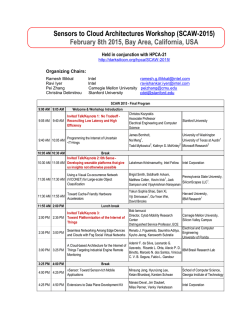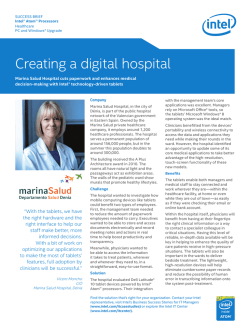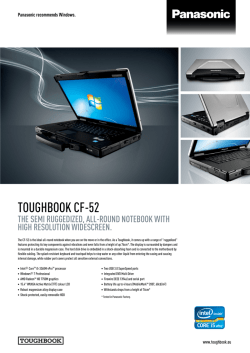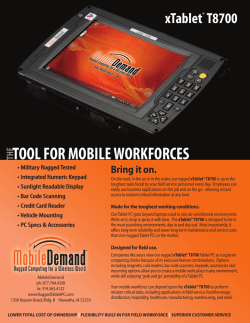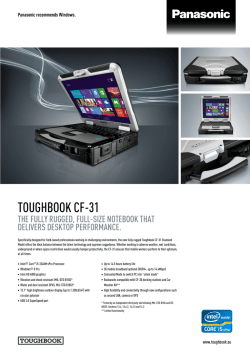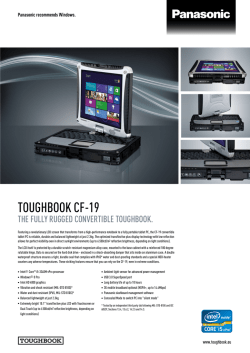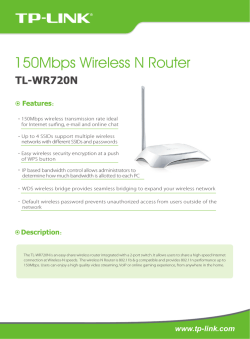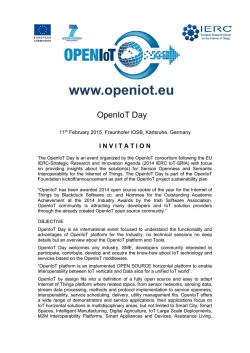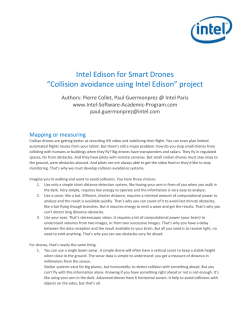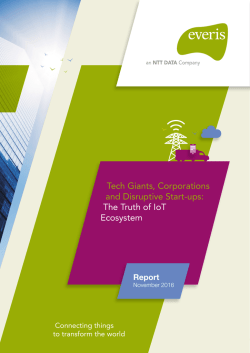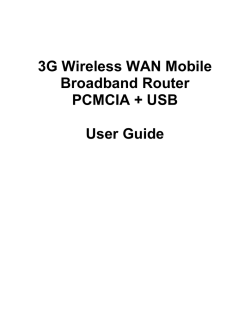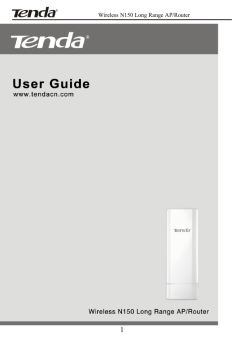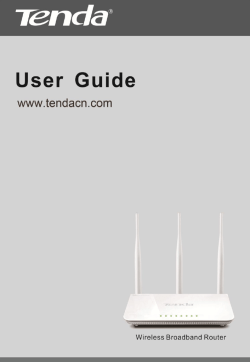
Print Friendly Version
US Headquarters 1000 N. Main Street, Mansfield, TX 76063, USA (817) 804-3800 Main www.mouser.com Technical Article Release 2014 Trends Lay Groundwork for 2015 Connected Devices by Steven Evanczuk, Mouser Electronics The Internet of Things (IoT) promises to construct a digital shadow of the physical world, and this presents opportunities that are tremendous in scope and profound in their implications. At the same time, realizing this vision of a massively interconnected life requires both the push of a critical mass of smart devices providing data and the pull of sophisticated applications providing services based on that data. The tech trends of 2014 revolved around the rising tide of technology and market forces elevating both the devices and applications needed to deliver on the promise of the IoT. IoT elicits the exciting vision of billions of smart devices pouring data into vast oceans of information deeply sounded by cloud-based Big Data applications offering services that we cannot yet fully appreciate. In 2014, the reality of the IoT is that it is a work in progress, as product vendors and engineers construct the basic foundation required to realize the eventual possibilities of the IoT. Indeed, 2014 saw more groundwork being laid for the IoT and wearables with announcements of devices and services that were important not just in their features and capabilities but also in the market forces behind their introduction. Postage-Stamp System Among the significant technology stories in 2014, Intel’s launch of a broad initiative for wearables made available new hardware, more design resources, and significant development backing. Announced at the Consumer Electronics Show (CES) and shipped in September, the Intel Edison is a postage-stampsize computer intended to help makers, engineers and companies more quickly field wearable designs. Built in an SD card form factor, the 35.5 x 25.0 x 3.9 mm computer is based on a 22-nm Intel SoC (system-on-chip) that includes a dual-core, dual-threaded 500 MHz Intel Atom CPU running Yocto Linux v1.6 and a 100 MHz 32-bit Intel Quark microcontroller running an RTOS. Along with the processor SoC, the computer combines 1 GB LPDDR3 PoP (package-on-package), 4 GB eMMC NAND flash, Bluetooth 4.0 and dual-band Wi-Fi supporting 802.11 a/b/g/n. In addition, the board includes an embedded 2.4/5 GHz antenna, a 70-pin connector and 40 GPIOs that can be configured as a number of different I/O connectivity options including USB, UART, I2C, SPI, and others. Even with that rich functional capability, the Edison consumes only 13 mW in standby mode (radios off). Intel bolstered release of its Edison system with a set of reference designs targeting wearables. Its reference design for smart earbuds updates conventional audio applications with the ability to support biometric and fitness information. The Intel smart earbud design provides full stereo audio and monitors heart rate and pulse, while mobile apps can track the user’s exercise activity. – continued – Figure 1:The Intel Edison is part of a Wearables campaign by Intel. Initiatives like these accelerate innovation by providing accessibility to everyone with low cost hardware, excellent documentation, and forum support. A smart-headset reference design leverages the Edison’s Bluetooth connectivity to integrate with existing personal-assistant technologies. The design combines voice recognition technology with Inteldeveloped firmware and software in a low-power headset that can be worn all day. Figure 2:Intel engineer Indira Negi demonstrates the smart ear buds she and her team designed. The ear buds harvest energy from the smartphone. Intel also included a reference design for a smart-wireless charging system, which allows users to drop devices such as the smart headset into a 10-inch bowl for battery recharging. Based on magnetic resonance technology in the A4WP industry specification, the reference design is capable of charging multiple devices simultaneously without requiring the kind of exact alignment or placement needed in earlier wireless charging systems. Along with hardware and reference designs, Intel also put its mark on the wearables landscape effort with its “Make it Wearable” challenge. Designed to recognize creative wearable designs, the challenge concluded in the Fall with awards amounting to more than $1.3 million. Mass Market Commitment Apple demonstrated its commitment to wearable designs with its announcement of the Apple Watch. Although not available until 2015, the Apple Watch combines notification and communications features with a variety of sensors. Along with built-in gyroscopic and accelerometer sensors, the Apple Watch can utilize GPS and Wi-Fi from a paired iPhone, which is required for use with the device. In addition, the watch includes infrared and visible-light LEDs and associated photodiode sensors for heart-rate detection. The Apple Watch uses a heart-rate detection method called pulse oximetry, which takes advantage of the difference in absorption of light at different wavelengths by oxygenated versus deoxygenated hemoglobin in the blood. Oxygenated blood absorbs more infrared light than deoxygenated blood, providing a differential method suitable for a wrist-worn heart-rate monitor for nonclinical applications. So many great technologies have fallen into the dustbin of market indifference that the efforts in turning the latest technology into the hottest mass-market product are noteworthy as well. In this context, some of the most significant technology stories of 2014 had less to do with startling new hardware and software than with mass-market movements. For example, Google’s acquisition of Nest sets the stage for the growth of more sophisticated services in the home and office built on Google’s pervasive presence in personal and business online activities. The ubiquitous focus on wearables and IoT in 2014 is not just hype. Critical progress has been made with integrated chips smaller than a flake of pepper. In January of 2014, Google announced development on a contact lens for diabetics that has an embedded glucose meter and wireless transmitter. The contact lens measures blood sugar via the tear fluid in the eye of the wearer and transmits that data through an antenna thinner than a human hair. Figure 3: The Google contact lens. From left to right: Close-up of a wireless chip; the chip, sensor and antenna mounted on an antenna/ring; and the ring embedded in a soft contact lens. The Kinetis L02 Series of MCUs is just one example of a very tiny 32-bit processor measuring just 1.9mm x 2.0mm in a Wafer Level Chip Scale Package (WLCSP). These innovations put true wearables within reach. Along with a small size, these chips must have ultra-low power requirements and many have energy harvesting features for the ultimate in self-sufficiency. LED Lighting Diversity One of the key enablers for the rise of these next-generation automation systems is the relatively rapid development of LED luminaires. LED lighting offers flexible illumination at a fraction of the power consumption of other lighting sources. Its ability to reduce energy costs continues to attract attention from major manufacturers looking to compete in an immense international market where lighting in the U.S. alone costs $58 billion a year and consumes about 22% of all electricity generated, according to the U.S. Department of Energy. The award of the 2014 Nobel Prize in physics to the creators of the blue LED acknowledged the vital importance of this special type of LED to the world at large. Blue LEDs enable manufacturers to produce white light – a basic requirement for residential, commercial and industrial illumination. With the ability to effectively tap into the multibillion dollar lighting market, advances in LED lighting have moved so quickly that LED lighting has graduated from a specialty purchase by early adopters to everyday devices available not only in big-box home improvement stores but in grocery stores, drug stores, and others. LED manufacturers have continued to pursue multiple approaches for providing consumers with LED luminaires at a broader range of price points and functional capability. In 2014, Cree introduced its 4Flow Filament Design, which uses convection ventilation to manage heat in LEDs. Prior to this innovation, LED bulb manufacturers have needed external heat sinks to dissipate heat in LED luminaires. In contrast, use of convection heat not only reduces material costs but also lowers manufacturing costs, allowing Cree to establish a breakthrough low-price point for LED lighting. Figure 4: Design features such as Cree’s 4Flow Filament Design and Filament Tower (shown here on the left) use the XLamp XT-E High Voltage White LEDs (shown on the right.) These products combine to deliver a lower price point for LED lamps. (Source: Cree, Inc.) LED manufacturers are working to lower cost with innovations in design and manufacturing. For example, newer materials approaches are replacing relatively expensive rare-earth elements with lower-cost alternatives – offering more color options at a lower cost. Similarly, manufacturers continue to investigate methods for enhancing the current use of sapphire or silicon carbide (SiC) with novel manufacturing techniques or replacing those materials entirely with lower-cost silicon substrates. While new materials and design methods help lower costs on one hand, LED manufacturers continue to push the functional capability of the lowly light bulb by adding intelligence to LED luminaires themselves. Built-in power management features combined with wireless control are appearing in growing numbers of off-the-shelf LED smart bulbs. Linked through mobile apps and external hubs such as the Wink system, these LED “lighting-system-in-a-bulb” devices allow fine control of illumination, hue and brightness in residential and business applications. Key Enabler Wireless communications remained an essential enabler of most leading technology trends in 2014. With so many fast-changing technologies vying for attention, the final approval in 2014 of 802.11ac as a formal IEEE standard gained relatively little attention. Yet, this wireless standard sets the stage for performance levels required to support consumers’ growing expectations for improved wireless connectivity. Offering significant advantages in performance and functionality, 802.11ac lies at the heart of highperformance wireless routers and devices in the consumer space. Compared to the popular existing 802.11n standard, 802.11ac offers wider channels, more advanced modulation and standardized beamforming that combine to enhance mid-range wireless connections. 802.11ac is not likely to soon replace the popular 802.11n by dint of sheer volume of 802.11n devices in the market. Still, it will likely quickly rise in prominence in the next wave of smartphones. Although supported in earlier MacBooks, Apple’s first smartphone to support 802.11ac appeared with the 2014 release of the iPhone 6. Another important boost for the connected world came from General Motors with its announcement of the availability of 4G LTE and Wi-Fi across its Chevrolet, Cadillac, Buick and GMC brands. The new OnStar feature will allow users to connect up to seven mobile devices in an in-vehicle wireless network with mobile Internet connectivity. This type of moving hot spot will play an increasing role in connected applications that underlie concepts such as Google’s vision of the connected world. Enhanced connectivity also forms the backbone of the manufacturing industry’s vision of the connected factory inherent in the Industry 4.0 concept. Here, IoT devices, connected equipment, and robots provide a productivity multiplier to the human worker. Intended to add both improved speed and safety to the manufacturing environment, Industry 4.0 relies on work cells where humans and semiautonomous robots work side by side. In this potentially hazardous environment, advanced safety capabilities are paramount and the semiconductor industry responded in 2014 with significant safety features in microcontrollers. MCU safety features are designed to trap computer errors that could create hazards for users and other machines in and near the area of operation. Features such as multicore lockstep operation, error checking and correction, fault detection and built-in self-test help MCUs identify and isolate errors that have safety implications. The industry has offered specialized MCUs with safety features in the past, but 2014 saw introduction of mainstream safety MCUs from processor core and MCU device manufacturers including ARM, Microchip Technology, and Texas Instruments. Still Waiting While new products and technology initiatives marked progress in 2014, the industry saw a number of promising efforts stall and other key enablers lose their image of invulnerability. Among these, wireless charging remains an area where the difficulties of delivering a critical mass of wireless charging products has not held up to the promise of the technology. Although the underlying technology provides needed capabilities, neither consumers nor mobile device manufacturers have been quick to settle on a wireless charging approach. Even in its iPhone 6, Apple went no closer to so-called free space wireless charging than an induction-based charging system that forms a tight, properly aligned connection between charger and phone. At another level of power distribution, the smart grid has failed to deliver on its promise in the U.S. for a variety of reasons. Although the technology is available, this initiative continues to face an uphill battle for acceptance. Among other stakeholder concerns, consumers have opted out of smart-meter installation, voicing concern over privacy and control. Arguably the largest technology failure in 2014, however, was security. Along with reports of millions of accounts compromised at retail stores, flaws in the security backbone of the Internet itself gained visibility in 2014. Two separate software problems, Heartbleed and Shellshock, reported in 2014 meant that most of the Internet was open to easy penetration by attackers. While Heartbleed involved a flaw in the OpenSSL cryptography library used to protect communications between clients and servers, Shellshock provided easy direct access to systems. Heartbleed is estimated to have affected over 66 percent of the sites on the Internet, while Shellshock is arguably considered a more widespread problem. Worse, while opportunistic attacks started as soon as the flaws were revealed, later inspection showed that the security flaws existed for years – since 2011 for Heartbleed and since 1989 for Shellshock – with unknown consequences. Similar security flaws in an IoT comprising billions of devices are unimaginable. It’s been a good year. Innovation in technology is increasing at an exponential rate, and open source efforts by Intel, STMicroelectronics, Arduino, and Texas Instruments are key to increasing that rate by making technology accessible via low cost devices, kits and development tools. IoT and wearables are established as segments for more than just cool tech toys with life-changing medical and industrial electronics. It’s going to be an exciting ride in the next decade. With remote-controlled personal drones here now and space-tourism in the near future, the sky is no longer the limit. 2014 Trends Lay Groundwork for 2015 Connected Devices
© Copyright 2025
